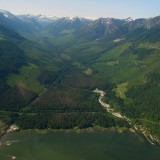Read this story from CBC.ca on the deal recently signed by the Haisla First Nation of Kitimat with the BC Government to fast-track a proposed Liquified Natural Gas plant in the Douglas Channel near their community. The gas would largely come from “fracking” operations in northeast BC and would be converted to liquid in order to be shipped by tanker to new markets in Asia. (Sept. 14, 2012)
The B.C. government has signed an agreement with the Haisla Nation to help fast-track another major liquefied natural gas (LNG) port facility near Kitimat.
The deal allows the Haisla to either lease or buy 700 hectares of land on the west side of the Douglas Channel in the areas around Haisla Reserve #6 and to work independently with the industry to develop a LNG marine export terminal on the site.
“If we are able to do this, the Haisla people will benefit, as will all British Columbians and Canadians,” said Ellis Ross, the Chief Councillor of the Haisla Nation.
The agreement comes as the B.C. government moves to slash spending to make up for a $1-billion budget deficit brought on by plunging North American natural gas prices.
But in Asia, natural gas fetches four to five times more than it does on the North American market, and that’s why the government is aiming to have three LNG export operations up and running by 2020, according to the Minister of Aboriginal Relations and Reconciliation Ida Chong.
“Currently British Columbia can only sell its natural gas on the North American market where there is ample supply and the commodity price is low, but by opening up new Asian markets where there is greater demand, British Columbian natural gas producers will be able to get up to four times the value,” said Chong.
The terminals would allow the province to export natural gas to emerging Asian markets, particularly Japan, China, South Korea, and India. Already two terminals have received export licences from the National Energy Board – Kitimat LNG and BC LNG Douglas Channel.
Spectra Energy and BG Group also announced plans Monday to build a LNG pipeline across northern B.C.
Read original story and watch video of the announcement: http://www.cbc.ca/news/canada/british-columbia/story/2012/09/14/bc-natural-gas-haisla.html


